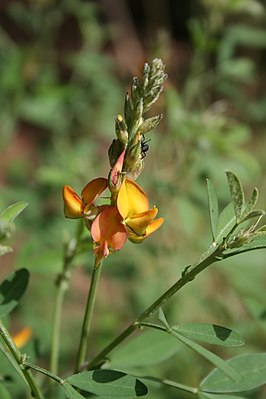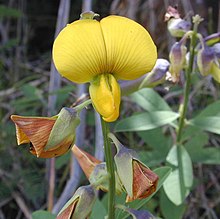Crotalaria
| Crotalaria | ||||||||||||
|---|---|---|---|---|---|---|---|---|---|---|---|---|

Inflorescence of Crotalaria naragutensis |
||||||||||||
| Systematics | ||||||||||||
|
||||||||||||
| Scientific name | ||||||||||||
| Crotalaria | ||||||||||||
| L. |
With about 690 species, Crotalaria is one of the most species-rich plant genera of the legume family (Fabaceae). The generic name is derived from κροταλον, the Greek word for castanets , and is derived from the same as the zoological generic name for the rattlesnake Crotalus .
description



Vegetative characteristics
The Crotalaria species grow as annual, biennial or perennial herbaceous plants or shrubs and reach heights of 0.3 to 3 meters, depending on the species. There are some xerophytes . Often all parts of the plant are hairy.
The alternate and spirally or two lines on the stem arranged distributed leaves are tiny assembled to very large, stalked to sessile and mono- or. If the leaf blade is compound then it is simply unpaired pinnate with one, often three to rarely seven leaflets . The two stipules can be fused with the petiole, sometimes they are only small, rarely missing.
Generative characteristics
The butterfly blossoms are seldom individually, mostly in racemose , spiky , capid or rarely bundled inflorescences . The inflorescences are terminal or axillary or opposite the leaves. There may be small to leaf-like bracts . There may be an outer calyx, it then usually consists of overgrown bracts.
The hermaphrodite, strongly zygomorphic , five-fold flowers are tiny to large with double perianth . The flower base is usually more or less cup-shaped and forms a gynophore in some species . The five sepals are fused with tubes, the calyx tube being at most the same length as the mostly identical to sometimes distinctly different calyx lobes. The colors of the five petals are mostly yellow to orange or brown, but occasionally also pink ( Crotalaria cornetii ) or blue ( Crotalaria variegata ); there are often clear, mostly darker patterns on the petals. Two petals have grown together to form a boat. The wings are not fused with the shuttle. The flag is only nailed briefly. There is no spur. There are ten fertile stamens , they are almost the same or clearly unequal. The stamens are Roehrig with each other, but not fused with the petals. The mostly free anthers are alternately long and basifixed or short and dorsifixed. There is only one carpel with two to a hundred ovules . Pollination is mostly done by insects ( entomophilia ).
The long to often relatively short and thick, almost spherical, straight or curved legumes are smooth to hairy. The legumes contain two to a hundred seeds. The small to very large seeds are more or less kidney-shaped and can sometimes have an aril . When the ripe seeds dissolve in the fruit and hit the solid pericarp when shaken, a sound like a rattle or castanet is produced, which is why the genus was given the scientific name and the English name "rattlepod".
symbiosis
Like many other legumes, species of the genus Crotalaria form root nodules in which symbiotic bacteria fix nitrogen. These bacteria belong either to the genus Bradyrhizobium , or to the genus Methylobacterium , which is known as a nitrogen-fixing symbiont only in Crotalaria species.
distribution
Crotalaria species mainly thrive in tropical to subtropical areas. The main focus of distribution of the pantropically widespread genus Crotalaria is with 510 species in tropical Africa, a secondary focus is the Neotropic with a little under 100 species. In Zimbabwe there are around 75 species, in Madagascar there are 48 species (33 of them are endemic, 10 are natural but are not endemic, 5 are invasive plants), 33 species are in Western Australia, in Nepal there are 31 species in There are eleven species each in China and Pakistan. Some species are invasive plants in many areas of the world .
Systematics
Synonyms for Crotalaria L. are: Goniogyna DC. , Heylandia DC. , Pentadynamis R.Br. , Priotropis Wight & Arn. , Quirosia Blanco .
Crotalaria belongs to the tribe Crotalarieae in the subfamily of the butterflies (Faboideae) within the family of the leguminous plants (Fabaceae). The genera Lotononis and Bolusia are closely related . The genus Crotalaria includes around 550 to 690 species.
use
The East Indian hemp ( Crotalaria juncea ) is used in Asia as a fodder plant, and on a smaller scale as a fiber plant and for green manure . Crotalaria longirostrata is a leaf vegetable found in Central America. Other species are used medicinally, as ornamental plants or forage plants.
swell
- Leslie Watson: Crotalaria in the Western Australian Flora : FloraBase - Online , 2008.
Individual evidence
- ^ A b c d G. Lewis, B. Schrire, B. Mackinder & M. Lock: Legumes of the world , RBG Kew, 2005, ISBN 1-900347-80-6
- ↑ A. Sy, E. Giraud, R. Samba, P. de Lajudie, M. Gillis & B. Dreyfus. Nodulation of certain legumes of the genus Crotalaria by the new species Methylobacterium. Canadian journal of microbiology 47 (6): 503-8. 2001.
- ^ Henry Y. Bernal M .: Crotalaria In: Polidoro Pinto, Pedro M. Ruiz (Ed.): Flora de Colombia , Vol. 4, 1986, p. 3
- ↑ a b c Crotalaria in the Germplasm Resources Information Network (GRIN), USDA , ARS , National Genetic Resources Program. National Germplasm Resources Laboratory, Beltsville, Maryland.
- ↑ a b Entry in the Flora of Madagascar . (engl.)
- ↑ a b c Entry in the Flora of China .
- ^ CG Cook, GA White: Crotalaria juncea: A potential multi-purpose fiber crop. , Pp. 389-394, In: J. Janick (Ed.): Progress in new crops , ASHS Press, Arlington, VA, 1996: [1]
Web links
- Entry in the Flora of Pakistan . (engl.)
- Entry in the Flora of Madagascar = Madagascar Catalog, Missouri Botanical Garden. (engl.)
- Entry in the Flora of Zimbabwe . (engl.)
- Crotalaria in the Germplasm Resources Information Network (GRIN), USDA , ARS , National Genetic Resources Program. National Germplasm Resources Laboratory, Beltsville, Maryland.
- Crotalaria in Neotropical Live Plant Photos, Field Museum, Chicago
- List of species of Crotalaria in ILDIS.
- Robert Hegnauer: Chemotaxonomy of plants: an overview of the distribution and the systematic importance of plant substances , Volume XIb-2, Birkhäuser, 2001: Crotalaria , P. 980-1029: - Ingredients and use, in Google Books.
- Crotalaria in U. Brunken, M. Schmidt, S. Dressler, T. Janssen, A. Thiombiano, & G. Zizka: West African plants - A Photo Guide . Senckenberg Research Institute, Frankfurt / Main 2008.











